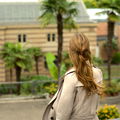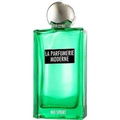Normally, I like to adhere to the perfumery farmer's rule of using fragrances that have any buildings, landscapes, or other realisms as a starting point only with the greatest possible spatial distance from them. In other words, no incense scents in the temple, smoky notes please not by the campfire, chocolate gourmands not at the chocolatier, realistic aquatics not by the sea, mechanic eaux not in the workshop, etc.
When I was able to spend several weeks at Lake Geneva (the name 'Genfersee' is rightly frowned upon outside of Geneva), it quickly became clear that I must make an exception to this rule, and Belles Rives is coming along.
Belles Rives, which translates to 'Beautiful Shores' in English, is so far the latest fragrance from La Parfumerie Moderne, the manageable brand with the charming name and the much-admired Marc-Antoine Corticchiato as the responsible perfumer. Here, too, a hotel story is supposed to hold, founder Philippe Neirinck occasionally speaks of the Beau Rivage Palace in Lausanne as well as the hotel of the same name in Geneva, known from Empress Elisabeth and later the Barschel affair, and of Proustian wordplay, without going into detail about it, but it should certainly refer to the fictional coastal resort Rives Belles along with hotel scenes from À la recherche du temps perdu.
Hotel or not, the Leman, the shores, and the area on the northern side, including the picturesque historical wine-growing region Lavaux in the hills between Lausanne and Montreux, do not smell of iris, the ingredient that Belles Rives dedicates itself to with the utmost attention, nor of osmanthus, which, depending on the location and variety, can certainly cope with this climate. Due to the sheer size of the lake, it resembles, in sections and under certain weather conditions, when the cold, dry 'La Bise' wind sweeps southwest over the lake, in a peculiar way a kind of salt-free sea; there are also algae and water flora and fauna. Belles Rives - a freshwater aquatic?
I wouldn't go that far, as the fragrance lacks any conventional aquatic note; instead, the scent is an oscillating texture in its purest form. Dynamic in the micro-total area yet at times static as a whole, composed of seemingly infinitely small components - the blending of the individual notes is masterful here, nothing stands out, yet the contours of the presenting facets are clearly recognizable, like stones at the bottom under a transparent shimmering freshwater layer.
Iris fragrances have probably been associated with the color gray since Jacque Fath's Iris Gris (1947), which created an authoritative-elegant, gray-toned impression with its peach-iris combination - even if this interpretation is more of a later cultural-historical reading. Serge Lutens’ Iris Silver Mist (1994) then definitively made this gray shading part of the program: a truly nebulous iris scent that, for me, well reflects the gray tones of the Parisian house fronts, and moreover, is a thoroughly urban fragrance. In 1988, Iris Bleu Gris by Jean François Laporte appeared as a comment on the note, one of the greenest of all iris perfumes, but as a child of the late 80s, it also comes with a certain announcement and is rather opulent.
Belles Rives is gray-green, with an ochre-yellow osmanthus shimmering beneath the surface (instead of Fath's peach?), with its slightly fruity, apricot-like nuances and a texture like the softest suede. This is central to the effect of the perfume: it takes away the iris's overly serious demeanor and skillfully distributes the powdery facets, making them appear juicy, plant-like, and softer. Hints of cinnamon-like elements - I must think of an extremely diluted Eau Lente (1986) in this aspect - and myrrh blur all edges and convey an appropriate depth as a base with a bit of Cosmone® (Givaudan: "Odor Description: Musky, Warm, Powdery. An intensely rich, powerful and elegant musk. The warm powdery facets of Cosmone are reminiscent of classic nitromusks with a subtle ambregris nuance.") while bergamot provides a crisp refreshing start.
UntermWert’s “consciousness-expanding iris understatement” describes the scent very well. In the context of La Parfumerie Moderne, Belles Rives is certainly the quietest, yet it excellently proves that a solid fragrance can indeed be soft-spoken. Corticchiato has designed some of his most remarkable works for La Parfumerie Moderne, all of which are more classic than, for example, his newer works at Parfum d’Empire. The state of the brand is unclear; in the current constellation of the five released perfumes, Belles Rives - although much more discreet than the four predecessors - is somewhat like a closed circle with Désarmant: there an opulent, nature-inspired lilac with greenery and spices, here an iris root in the wild with osmanthus modulation and a warm-spicy base, staged at the beautiful shores of the lake. Belles Rives smells perfumey enough in every section that any fears it might be a bottled landscape do not even arise - yet the idyll is coherent. Great fragrance.
/
I wrote this text more than two years ago and felt no need to publish it immediately, perhaps because I was surprised and embarrassed that I had managed to comment on all the fragrances from a brand, which in the meantime has either entered a permanent winter slumber or has simply been definitively concluded. However, over the past year, I have encountered so many fragrances in vivo, that is, on sidewalks, in pedestrian zones, restaurants, etc., all of which stubbornly vie for attention - whether through floral-fruity-woody-amber-oud-whatever-in-your-face banalities, through hearty overdosing by the owners, or the latest scent-chemical achievements in sillage terrorism - that refined and not so boisterous releases like this one gain even more value for me.






 Top Notes
Top Notes  Frankincense
Frankincense Italian bergamot
Italian bergamot Somalian myrrh
Somalian myrrh Heart Notes
Heart Notes  Florentine iris
Florentine iris Osmanthus
Osmanthus Jasmine sambac
Jasmine sambac Base Notes
Base Notes  Cosmone
Cosmone Texas cedar
Texas cedar Haitian vetiver
Haitian vetiver











 Lucasai
Lucasai Seta
Seta JonasP1
JonasP1 Theris
Theris Yatagan
Yatagan Knopfnase
Knopfnase Floyd
Floyd SchatzSucher
SchatzSucher Gold
Gold SirLancelot
SirLancelot









